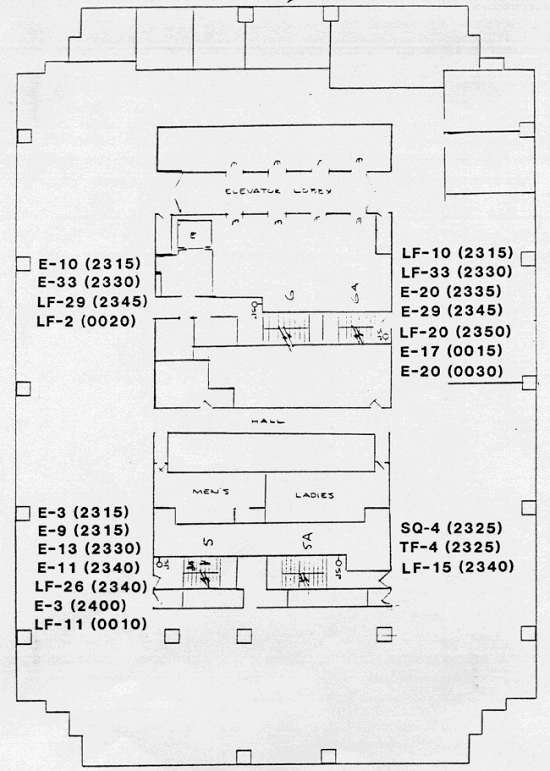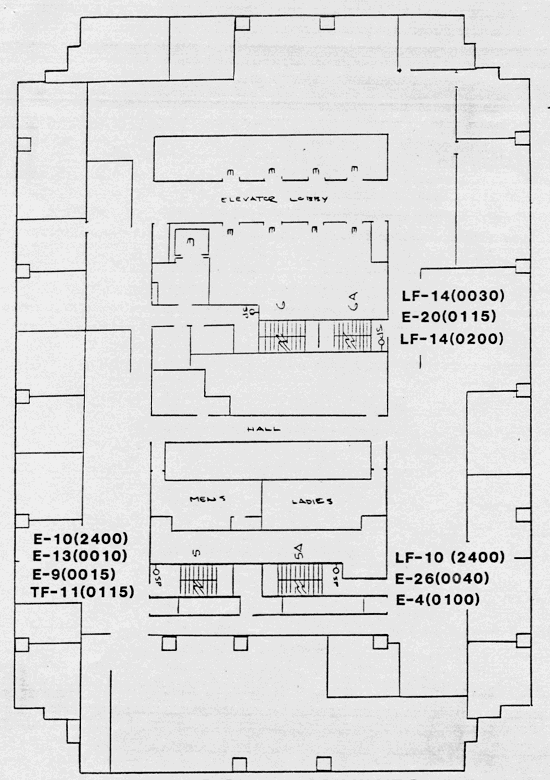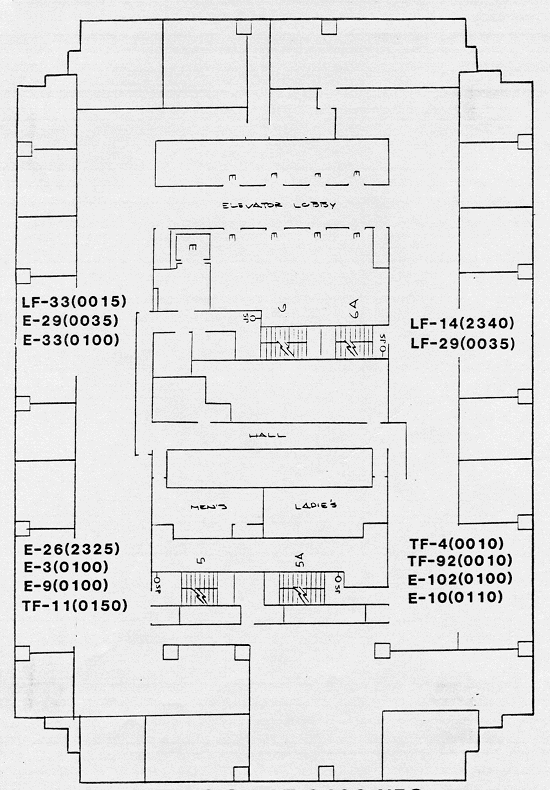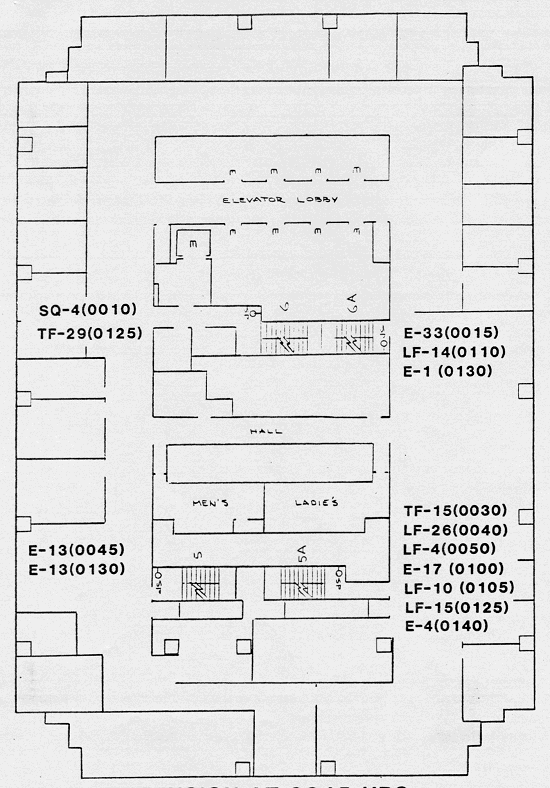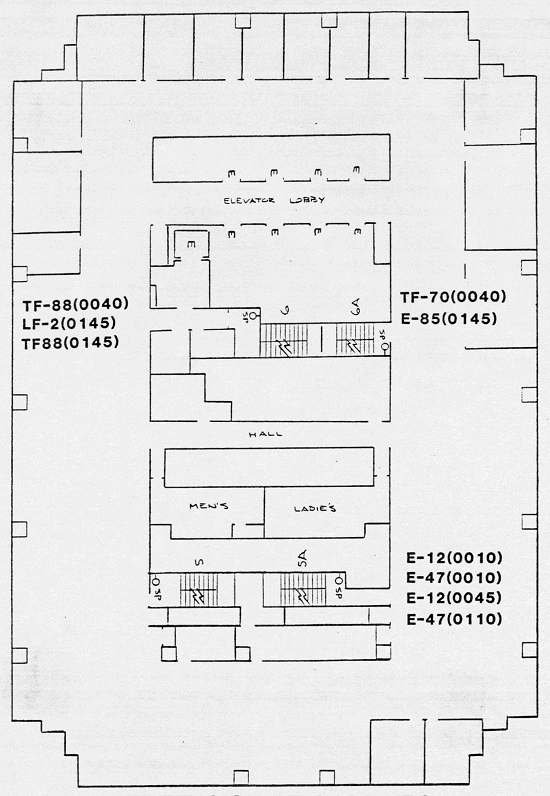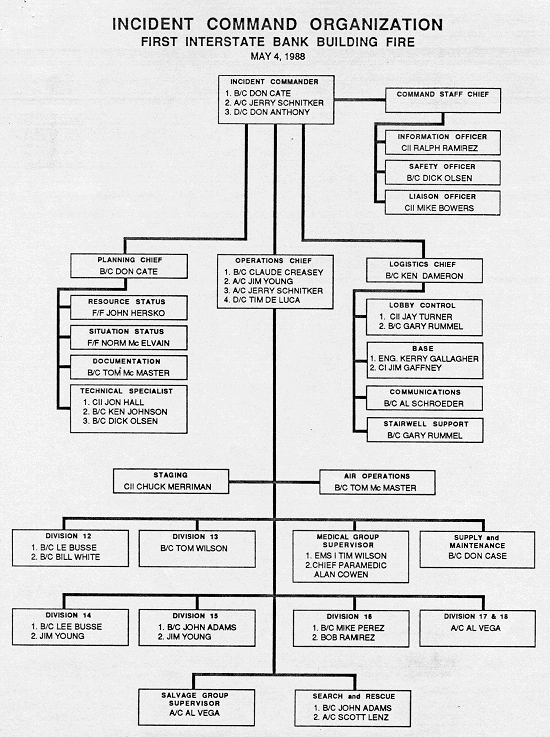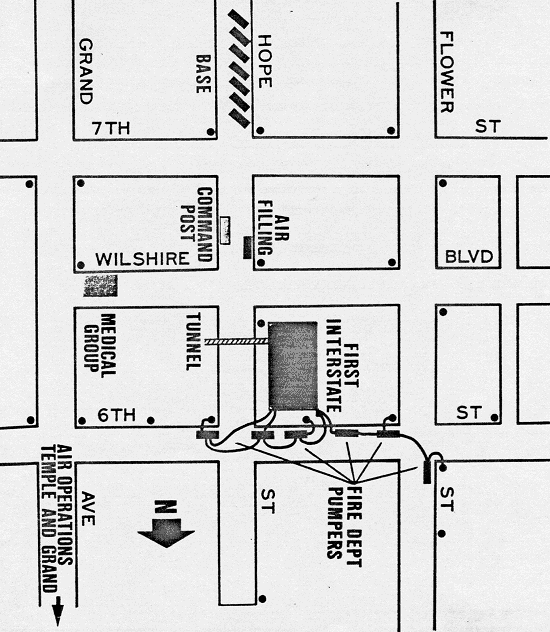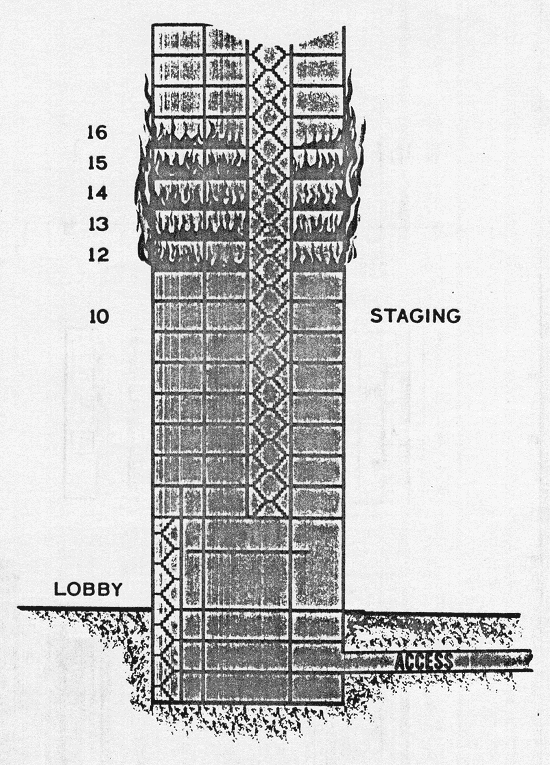|
CHAPTER 1 EXECUTIVE
SUMMARY The Fire: On May 4 and 5, 1988, the Los Angeles City Fire Department responded to an extinguished the most challenging and difficult high-rise fire in the City's history. The fire destroyed five floors of the First Interstate Bank Building, which some experts say could mean the loss of the entire structure. It was the high-rise fire that "you can't put out." It took a total of 383 Department members to do the job. They fought the blaze for 3 hours and 39 minutes to knock it down. In the process, they flowed one-half million gallons of water through 10,000 feet of fire hose and literally fought their way onto the fire floors from the hot, crowded, smokey stairwells. In addition, during the course of the First Interstate Fire, the Los Angeles City Fire Department responded to 87 other incidents which included 74 emergency medical service responses, eight of which were heart attacks; three structure fires; three fires outside of a structure; five false alarms; a lock out' and a natural gas leak. Donald O. Manning,
Fire Department Chief Engineer and General Manager, managed all Department
operations during the entire incident. Through the personal skills,
knowledge, dedication, and perseverance of all members, and the Chief
Engineer's guidance and confidence, the First Interstate Bank building fire
was brought to a successful conclusion. |
|||||||||||||||||||||||||||||||||||||||||||||||||||||||||||||||||||||||||||||||||||||||||||||||||||||||||||||||||||||||||||||||||||||||||||||||||||||||||||||||||||||
|
-5-
At 2222 hours, the building's two fire pumps were shut down by the sprinkler contractor, and the combination standpipe system was drained down to the 58th floor level to facilitate connecting the new sprinkler system to the standpipe at that level. Three minutes later, at 2225 hours, an employee of the sprinkler system contractor heard glass falling and saw light smoke at the ceiling level. A manual pull alarm on the 5th floor was pulled and after sounding for 2 seconds went dead. At 2230 hours, a smoke detector on the 12th floor was activated. It was reset by security company personnel. At 2232 hours, three smoke detectors on the12th floor were activated. They were again reset by security personnel. At 2234 hours, four smoke detectors on the 12th floor were activated and again reset by security personnel. At 2236 hours, multiple smoke detector alarms from the 12th to the 30th floors activated. A maintenance employee took service elevator #33 to the 12th floor to investigate the source of the alarms. The employee died in the elevator. At 2237 hours, the Fire Department's Operations Control Dispatch Section (O.C.D.) received three separate 911 calls from persons outside of the First Interstate Building reporting a fire on the upper floors. At 2238 hours, O.C.D. dispatched a Category "B" assignment to Wilshire and Hope Streets.
|
|||||||||||||||||||||||||||||||||||||||||||||||||||||||||||||||||||||||||||||||||||||||||||||||||||||||||||||||||||||||||||||||||||||||||||||||||||||||||||||||||||||
|
-6- It took two minutes for Battalion Chief Don Cate, Battalion 1, "C" Platoon, to reach the First Interstate Bank Building. While en route, he observed and reported a large "loom-up" in the general area of the building. When he arrived on the scene, he observed the entire east side and there-fourths of the south side of the 12th floor fully involved with fire. Chief Cate called for fifteen additional fire companies and five additional Chief Officers. He then directed his initial assignment of six companies to attack the fire and began to set up the High Rise Incident Command System. Engine 3, Engine 9, Task Force 10, and Squad 4 were directed to proceed aloft and attack the fire. Engine 3 and Engine 9 attacked the fire on the 12th floor form the southwest stairwell using two, 2-inch lines. They had low water pressure on those lines for several minutes. Fire Department pumping apparatus on 6th Street pumped into the combination standpipe systems. Once the building's fire pumps were placed back in service, the lines produced good streams. Task Force 10 attacked the fire on the 12th floor from two locations using Stairwells 6 and 6-A, located in the northeast and northwest portion of the building. Squad 4 joined forces with Task Force 4 to attack the fire from Stairwell 5-A, which provided access to the southeast portion of the 12th floor. By 2330 hours, the initial alarm assignment was conducting simultaneous fire suppression operations from four different stairwells on the 12th floor. Light Force 9 set up lobby control on the first floor and Light Force 3 set up staging on the 10th floor. Engine 9, Engine 209, and Engine 210 were positioned on the north side of the building on 6th Street and supplied water to the combination standpipe inlets. O.C.D. dispatched the additional Chief Officers and fire companies that Wilshire IC requested. The total Fire Department commitment to the fire at 2242 hours was one Assistant Chief, six Battalion Chiefs, seven Task Forces, seven Engine Companies, one squad and two helicopters, for a total personnel complement of 118 members. |
|||||||||||||||||||||||||||||||||||||||||||||||||||||||||||||||||||||||||||||||||||||||||||||||||||||||||||||||||||||||||||||||||||||||||||||||||||||||||||||||||||||
|
-7- Assistant Chief Jerry Schnitker, Division I, "C" Platoon, arrived on the scene at 2246 hours. He provided O.C.D. with a complete size-up of the fire and, after conferring with Battalion 1, established the following Incident Command System Organization:
At 2249 hours, Wilshire IC requested O.C.D. to double the present assignment of 21 companies for a total of 42 companies assigned to the incident. In addition, Wilshire IC requested one more Assistant Chief to be dispatched to the fire. As the major emergency companies arrived on the scene, they were sent to staging and given the following assignments by Operations.
Many of the first arriving companies attacked the fire four and five times form different locations. They were resupplied and reassigned in staging. A matrix of their reassignments is contained at the end of this chapter. At 2305 hours,
Wilshire IC assigned Engine 17 the task of turning the building's fire
pumps back on. Engine 17 and a Water System Engineer entered the
building and reactivated the fire pumps at approximately 2320 hours. |
|||||||||||||||||||||||||||||||||||||||||||||||||||||||||||||||||||||||||||||||||||||||||||||||||||||||||||||||||||||||||||||||||||||||||||||||||||||||||||||||||||||
|
-8- Wilshire IC also made the following assignments and reassignments at approximately 2315 hours:
At 2309 hours, Wilshire IC directed Battalion 5 to set up Air Operations at Temple and Grand Avenue. Air Operations supported the activities of Airborne Engine Companies 78 and 100 on the roof and the four helicopters that were assigned to the fire. Air Operations ground support activities we3re provided by Engine 37 and Light Force 85 and 102.
At 2322 hours, Deputy Chief Donald F. Anthony arrived on scene and took command of the fire. After providing O.C.D. with an in-depth size up, he assigned Division 1 to replace Division 2 in Operations. At 2345 hours, Chief Anthony requested that O.C.D. assign Assistant Chief Ramirez, Division 3 Commander, to the fire. He requested that Assistant Chief Ramirez and Assistant Chief Young, Division 2, report to the command post for a planning meeting. At 2400 hours, Chief Anthony assigned Chief Ramirez to the 16th floor with four companies to stop the fire there. Chief Young was assigned to coordinate the fire attack on the 14th and 15th floor. Chief Young relayed the plan to Operations when he reported back to staging. Two major problems
produced negative impacts on fire suppression efforts at 2400 hours.
The first was overloaded radio communications between Wilshire IC,
Operations, and Division Commanders. The second was the logistical
problem of supplying staging with needed air bottles, hose, and other
equipment. At 0010 hours, Battalion Chief Alan Schroeder was
assigned to work with Operations as Communications Officer. At 0030
hours, stairwell support was initiated with the assignment of the first of
nine companies to that function under the direction of Chief Rummell in
lobby control. |
|||||||||||||||||||||||||||||||||||||||||||||||||||||||||||||||||||||||||||||||||||||||||||||||||||||||||||||||||||||||||||||||||||||||||||||||||||||||||||||||||||||
|
-9- At 0130 hours, the 15th floor was fully involved with fire and was starting to expose the 16th floor. The offices in the north end of the 16th floor were starting to burn due to extension of the fire through the space between the floor and the glass curtain wall exterior. Division 3 and Battalion 10 (Chief Perez) directed Engine 12, Engine 47, Task Force 70, and Task Force 88 in protection of the 16th floor as the companies working below made an all out assault on the 14th and 15th floors. The fire was officially declared "knocked down" at 0219 hours. At that point, water control and salvage operations were started under Chief Vega and Chief Young's directions. Search and rescue efforts continued until all people were removed from the building and transported to local hospitals. |
|||||||||||||||||||||||||||||||||||||||||||||||||||||||||||||||||||||||||||||||||||||||||||||||||||||||||||||||||||||||||||||||||||||||||||||||||||||||||||||||||||||
|
FIRE ATTACK
ASSIGNMENTS
|
|||||||||||||||||||||||||||||||||||||||||||||||||||||||||||||||||||||||||||||||||||||||||||||||||||||||||||||||||||||||||||||||||||||||||||||||||||||||||||||||||||||
|
|||||||||||||||||||||||||||||||||||||||||||||||||||||||||||||||||||||||||||||||||||||||||||||||||||||||||||||||||||||||||||||||||||||||||||||||||||||||||||||||||||||
|
|||||||||||||||||||||||||||||||||||||||||||||||||||||||||||||||||||||||||||||||||||||||||||||||||||||||||||||||||||||||||||||||||||||||||||||||||||||||||||||||||||||
|
|||||||||||||||||||||||||||||||||||||||||||||||||||||||||||||||||||||||||||||||||||||||||||||||||||||||||||||||||||||||||||||||||||||||||||||||||||||||||||||||||||||
|
|||||||||||||||||||||||||||||||||||||||||||||||||||||||||||||||||||||||||||||||||||||||||||||||||||||||||||||||||||||||||||||||||||||||||||||||||||||||||||||||||||||
|
|||||||||||||||||||||||||||||||||||||||||||||||||||||||||||||||||||||||||||||||||||||||||||||||||||||||||||||||||||||||||||||||||||||||||||||||||||||||||||||||||||||
|
FIRST INTERSTATE BANK BUILDING FIRE MAY 4, 1988 ANALYSIS OF FIRE GROUND OPERATIONS - OBSERVATIONS AND RECOMMENDATIONS
|
|||||||||||||||||||||||||||||||||||||||||||||||||||||||||||||||||||||||||||||||||||||||||||||||||||||||||||||||||||||||||||||||||||||||||||||||||||||||||||||||||||||
|
-2-
|
|||||||||||||||||||||||||||||||||||||||||||||||||||||||||||||||||||||||||||||||||||||||||||||||||||||||||||||||||||||||||||||||||||||||||||||||||||||||||||||||||||||
|
-3-
|
|||||||||||||||||||||||||||||||||||||||||||||||||||||||||||||||||||||||||||||||||||||||||||||||||||||||||||||||||||||||||||||||||||||||||||||||||||||||||||||||||||||
|
CHAPTER 3 BY CAPTAIN II EDWARD K. STEPHENS FIRE PREVENTION BUREAU In the early 1970's plans for a new 62-story corporate headquarters building in Los Angeles were being completed. The building was being built to bring United California Bank's corporate headquarters, UBC's Los Angeles Main Office, and its multi-state bank holding company, together under one roof. The plan was for the holding company, with its majority ownership of UBC and 22 other affiliated banks, to occupy two upper floors in the tower while the other remaining floors not needed for bank use would be available for lease. The new structure, designed by Charles Luckman Associates, Los Angeles, was destined to anchor the skyline for the city's emerging financial district on the south end of downtown. For the first time, Los Angeles' banking center was moving from historic Spring Street. The new corporate headquarters tower at 707 Wilshire Boulevard was designed to become the tallest building west of Chicago. The 858-foot high landmark is accentuated by gray solar and glass spandrels rising the full height of the tower. Substantial setback from both Sixth Street and Wilshire Boulevard was designed to create generous open plaza areas to the north and south of the tower. The project was unique in that it was completed on time and under budget. During the construction, a number of records were set; for instance, the pouring of the foundation for the building was one of the largest continuous cement pours made in the century. Some of the records that were set at the time have subsequently been broken. Since that time a number of taller buildings have been built. The building was first occupied near the end of October, 1973.
|
|||||||||||||||||||||||||||||||||||||||||||||||||||||||||||||||||||||||||||||||||||||||||||||||||||||||||||||||||||||||||||||||||||||||||||||||||||||||||||||||||||||
|
The Tower is constructed of structural steel moment-resisting space frame and composite concrete and steel decking. Anodized aluminum mullions with spandrel glass curtain walls form the building's structure which rests on reinforced concrete spreadings and a reinforced concrete mat foundation. The architectural design provides typical floor plans averaging 17,500 net rentable square feet. Center core construction places the elevators and stairways in the middle of the building. Mechanical rooms are located on floors 4, 5, 22, 42, 61, and 62. The building also has a heliport. An employee cafeteria occupies the entire 6th floor area, and a small kitchen is located on the 60th floor. Vertical transportation consists of 25 passenger elevators manufactured and maintained by Otis Elevator Company. These elevators serve all of the tower's floors through four banks. Additionally, there are three parking level shuttle elevators, two dedicated freight elevators and two escalators. The Building has three stairshafts. Heating ventilation, and air-conditioning is a high velocity, dual-duct type with a heating loop and a cooling loop around the inner core area. The building fire protection systems include a Class II (combination) standpipe system serving all portions of the building above the mezzanine, and complex fire alarm and fire warning systems. An 85,750 gallon reservoir is on site. The basement and tunnel have automatic sprinklers, emergency power is supplied by a generator on the roof. The fire alarm annunciator panel is located on the wall behind the security desk on the basement level. - 2 - |
|||||||||||||||||||||||||||||||||||||||||||||||||||||||||||||||||||||||||||||||||||||||||||||||||||||||||||||||||||||||||||||||||||||||||||||||||||||||||||||||||||||
|
As directed by the holding company, which owned United California Bank and various other banks in 11 western states, the name was changed to First Interstate Bank. The change occurred in June of 1981, and provided the holding company an opportunity to have all of its banks under one name.
|
|||||||||||||||||||||||||||||||||||||||||||||||||||||||||||||||||||||||||||||||||||||||||||||||||||||||||||||||||||||||||||||||||||||||||||||||||||||||||||||||||||||
|
|
|||||||||||||||||||||||||||||||||||||||||||||||||||||||||||||||||||||||||||||||||||||||||||||||||||||||||||||||||||||||||||||||||||||||||||||||||||||||||||||||||||||
|
CHAPTER 5 High Rise Incident Command System First Interstate
Bank Building Fire by Thomas E. McMaster,
Battalion Chief The following is a description of the Los Angeles City Fire Department's high rise Incident Command System (ICS) as it was implemented at the First Interstate Bank building fire. A complete description of the high rise ICS organization is contained in the second part of this chapter. Chief Engineer Chief Engineer and General Manager Donald O. Manning was notified of the First Interstate Bank fire at 2247 hours. Chief Manning arrived on scene at 2315 hours and remained until 0400 hours during which time he oversaw all operations. Incident Commander Battalion
1 (Battalion Chief Donald L. Cate) was dispatched to the First Interstate
Bank building fire at 2238 hours on May 4, 1988. At 2240 hours, he
reported on scene and in charge of the incident. After his initial
size-up to the Operations Control Dispatch Section (OCD), Battalion 1
preformed the following ICS functions:
|
|||||||||||||||||||||||||||||||||||||||||||||||||||||||||||||||||||||||||||||||||||||||||||||||||||||||||||||||||||||||||||||||||||||||||||||||||||||||||||||||||||||
|
- 2 -
|
|||||||||||||||||||||||||||||||||||||||||||||||||||||||||||||||||||||||||||||||||||||||||||||||||||||||||||||||||||||||||||||||||||||||||||||||||||||||||||||||||||||
|
- 3 -
|
|||||||||||||||||||||||||||||||||||||||||||||||||||||||||||||||||||||||||||||||||||||||||||||||||||||||||||||||||||||||||||||||||||||||||||||||||||||||||||||||||||||
|
- 4 -
|
|||||||||||||||||||||||||||||||||||||||||||||||||||||||||||||||||||||||||||||||||||||||||||||||||||||||||||||||||||||||||||||||||||||||||||||||||||||||||||||||||||||
|
- 5 -
Operations Battalion 11 arrived on scene at 2246 hours and was assigned to Operations by the Wilshire IC. He entered the building by the first floor, southwest entrance to avoid being struck by falling glass. After checking in at Lobby Control, he climbed to the 12th floor in Stairwell 5-A. Enroute he heard Engine 3's communication about low water pressure and upon arriving at the 12th floor, found it fully involved. Operations returned
to the 10th floor, passing Squad 4 on their way up as a Fire Attack
Team. Light Force 11 assisted Operations by forcing the door open to
the 10th floor. Operations notified Wilshire IC that he was set up
on the 10th floor and that fire attack would occur from multiple
stairwells. At approximately 2340 hours, Operations directed Light
Force 11 and Light Force 2 to check conditions on the floors above the
fire and report back. Light Force 11 reported that the 13th floor
was well involved and the 14th floor had heavy smoke at floor level with
the potential for flashover. Light Force 2 reported that the 14th was
charged with heat and smoke and the 15th floor was hot but tenable.
Operations directed incoming companies to get above the fire per instructions
from the Wilshire IC. |
|||||||||||||||||||||||||||||||||||||||||||||||||||||||||||||||||||||||||||||||||||||||||||||||||||||||||||||||||||||||||||||||||||||||||||||||||||||||||||||||||||||
|
- 6 - At 2306 hours, Division II arrived on scene at the fire and reported to the Wilshire IC. Division II was directed to report to the 10th floor and relieve Battalion 11 as Operations. At 2328 hours, Division II arrived on the 10th floor and made an assessment of staging and firefighting operations. At 2338 hours, Division II made face-to-face contact with Battalion 11 and informed him that he was relieving him as Operations Commander. Battalion 11 maintained liaison between Operations and Division Commanders for the remainder of the incident. At 2325 hours, Division I was relieved as Wilshire IC and became Operations. He initially set up in the Battalion 1 sedan but was unable to communicate with in the building. At 2340 hours, he informed Wilshire IC that he was moving Operations to the 10th floor to facilitate communications. He relieved Division II on the 10th floor at 2355 hours. During
the next 2-1/2 hours, Operations performed the following high rise
Incident Command System functions:
|
|||||||||||||||||||||||||||||||||||||||||||||||||||||||||||||||||||||||||||||||||||||||||||||||||||||||||||||||||||||||||||||||||||||||||||||||||||||||||||||||||||||
|
- 7 - Information Officer At
approximately 2325 hours, Captain I Ralph Ramirez, of the Department's
Public Service Unit, reported to the Wilshire IC and was assigned as Information
Officer. Also assigned were Inspector Ed Reed, Firefighter Gary
Svider, and Firefighter Jim Wells of OCD. Their assignments were as
follows:
The ICS Information Officer position was demobilized at 0830 hours on May 5, 1988. However, the Public Service Unit continued working with the media for several weeks. Planning Chief At 2250 hours, Battalion 1 was assigned to the position of Planning Chief. He continued to handle fire command radio communications for the Incident Commander. In addition, the Planning Chief continued to monitor resource status and situation status using the Battalion 1 and Division I Adjutants as Form-666 record-keepers. Technical Specialists At approximately 2335 hours, Captain II John A. Hall reported to Wilshire IC as the on-call commander of the Engineering and Hydrant Unit. Wilshire IC assigned him to be the Water Resources Officer and directed that he evaluate the water supply and the feasibility of charging the fire sprinkler system on the 17th, 18th, and 19th floors (see Chapter 10).
|
|||||||||||||||||||||||||||||||||||||||||||||||||||||||||||||||||||||||||||||||||||||||||||||||||||||||||||||||||||||||||||||||||||||||||||||||||||||||||||||||||||||
|
- 8 - At 2355 hours, Battalion Chief Kenneth L. Johnson, Fire Prevention Bureau, reported to the fire and was assigned as Water Resources Officer. At 0040 hours, Battalion Chief Richard E. Olsen reported to the fire as the on-call Staff Safety Officer. At 0100 hours, the Wilshire IC directed him to take over as the Water Resources Officer and coordinate the evaluation of the fire sprinkler system with Captain Hall, Engine 85, and Truck 50. The fire pump performance and the 85,750 gallon water tank were checked and found to be adequate for firefighting use. The Water resources Officer advised Wilshire IC that activation of the fire sprinkler systems could have a negative impact on firefighting streams so the decision was made not to activate them. The Water resources Officer also coordinated the shut-down of the combination standpipe system, after the fire was knocked down, to repair leaking pressure reducing valves. Documentation Officer At 0400 hours, Wilshire IC directed Battalion Chief Thomas E. McMaster to be the Fire Department Historian for the fire. Logistics Chief At 2247 hours, Wilshire IC assigned Battalion 7 to the position of Logistics Chief. Battalion 7 remained in command of logistics for the entire fire, supervising the functions of Base, Lobby Control, and Stairwell Support. The sound-powered phones built into the building were used during the fire, but they were very weak. That, coupled with the background noise at their location, rendered them useless. Building access presented a major problem to the Logistics Officer from the early minutes of the fire due to falling glass and debris. At 2340 hours, a safe route to Lobby Control was established using the pedestrian tunnel under Hope Street.
|
|||||||||||||||||||||||||||||||||||||||||||||||||||||||||||||||||||||||||||||||||||||||||||||||||||||||||||||||||||||||||||||||||||||||||||||||||||||||||||||||||||||
|
- 9 - Due to the critical and immediate need for additional Fire Attack Teams on the fire floors, Stairwell Support was not set up until approximately 0030 hours. This and the tremendous demand for equipment and air bottles created by the magnitude of the fire placed a major strain on logistics. Base Base was initially staffed by the Engineer form Engine 229, when he arrived on scene at 2303 hours. At 2306 hours, Engine 15 was assigned to take command of Base operations. Working with the Los Angeles Police Department, the Base commander developed a traffic control plan and a parking plan for the Base area. At 2313 hours, Wilshire IC directed the Base commander to transport air bottles from Emergency Air 1 into Lobby. the Base commander was then directed to mark the tunnel route from Base to Lobby using yellow tape. Engine 15 eventually joined Light Force 15 in fire attack on the 15th floor, leaving Base under the care of the Engineers form Engines 229 and 15. Lobby Control Light Force 9 was assigned to Lobby Control by the Wilshire IC on their arrival at 2241 hours. Engine 209 laid lines and supplied water to the building standpipe connections, which left the personnel from Truck 9 to staff Lobby Control (five members). Lobby Control was initially set up outside the building at the street exit to Stairwell 5. Falling glass on the south side of the building prevented additional companies from entering the building at that location. Lobby Control was relocated to the north side of the first floor lobby, off of 6th Street. At 2315 hours, Battalion 9 assumed command of Lobby Control as directed by Wilshire IC. After reporting to the Logistics Commander, Lobby Control attempted to set up communications using the public telephone
|
|||||||||||||||||||||||||||||||||||||||||||||||||||||||||||||||||||||||||||||||||||||||||||||||||||||||||||||||||||||||||||||||||||||||||||||||||||||||||||||||||||||
|
- 10 - system. The telephones in the lobby were not working. The building sound-powered telephone was used to connect Staging; however, the signal was weak and broken. Stairwell Support Wilshire IC established Stairwell Support Teams at approximately 0030 hours. Five companies were used to transfer equipment vertically in the stairwell, and four companies were used to move equipment from Base to Lobby Control. The long and circuitous path from Base to Staging placed extreme physical demands on the personnel assigned to both Stairwell and Ground Support. Water was cascading down the stairwells, and the stairwell emergency lighting system was inoperative due to fire damage. As flashlight batteries dimmed, conditions in the stairwell became difficult. The members assigned functioned with little rest until Stairwell Support was demobilized at 0330 hours. Communications At 2355 hours, Battalion Chief Alan T. Schroeder reported to Wilshire IC as the on-call Staff Battalion Chief. He was directed to report to the Operations commander on the 10th floor and assist with command of fire suppression activities. He arrived in Staging at approximately 0015 hours and after conferring with Operations, was assigned as Communications Officer. The Communications Officer remained on the 10th floor and facilitated radio communications between Operations, Wilshire IC, Lobby Control, and firefighting Divisions on upper floors. The Communications Officer continued to operate at the fire until 0530 hours on May 5, 1988. Staging Light Force 3 was assigned to set up Staging when they arrived at the fir at 2245 hours. They arrived on the 10th floor and established it as the Staging area at 2305 hours. During the early minutes of the
|
|||||||||||||||||||||||||||||||||||||||||||||||||||||||||||||||||||||||||||||||||||||||||||||||||||||||||||||||||||||||||||||||||||||||||||||||||||||||||||||||||||||
|
- 11 - fire, it was difficult to maintain reserves in Staging due to the immediate demand for Fire Attack Teams. Communication was difficult due to heavy radio use. A public telephone was used to contact the Wilshire IC via OCD. Light Force 3 remained in command of Staging until relieved by the on-coming platoon at 0730 hours. Air Operations At 2309 hours, the Wilshire IC directed Battalion 5 to set up Air Operations at Temple Street and Grand Avenue (See Chapter 7). Medical Group Supervisor At 2318 hours, the Wilshire IC set up a Medical division at the intersection of Wilshire Boulevard and Grand Avenue (See Chapter 8). Division 12 Battalion 2 arrived on scene at 2252 hours and was assigned to command Division 12 by the Wilshire IC. He proceeded up Stairwell 6-A to the 12th floor where he found the Operations commander (Battalion 11). Division 12 was the second chief officer on the fire floors. He coordinated the fire attack on floors 12 and 13 using Stairwells 6 and 6-A which are interconnected. At 2315 hours, Division 12 was reassigned to command Division 14. Battalion 13 arrived on scene at 2252 hours and was directed to take command of Division 12 at approximately 2315 hours. Using Stairwells 5-A and 6-A, Battalion 13 directed Fire Attack Teams operating on the 12th floor. Division 13 Battalion 3 arrived on scene at 2252 hours and was assigned to command Division 13 by the Wilshire IC. At approximately 2307 hours, Battalion 3 reported to Operations at Staging and was reassigned to Division 12. At 2312 hours, Battalion 3 arrived on the 12th
|
|||||||||||||||||||||||||||||||||||||||||||||||||||||||||||||||||||||||||||||||||||||||||||||||||||||||||||||||||||||||||||||||||||||||||||||||||||||||||||||||||||||
|
- 12 - floor in Stairwell 5-A and observed Task Force and Squad 4 engaged in fire attack. They had low water pressure at the time. At 2325 hours, Light Force 33 was directed to check out the 13th and 14th floors from Stairwell 5-A and report back. At 2335 hours, Battalion 3 was instructed by Operations to take command of firefighting operations in Stairwell 5 and 5-A. Task Force 11 was assigned to be Division 12 at that time. Battalion 3 directed firefighting operations on three floors until 0130 hours when he was reassigned to the 15th floor. Division 14 Battalion 14 arrived at the fire at 2325 hours and was initially assigned to Search and Rescue above the fire by Wilshire IC. Operations reassigned Battalion 14 to command Division 14 at approximately 2400 hours. Battalion 14 worked on the fire on the 14th floor until knock-down at 0219 hours. Division 15 At approximately 2400 hours, Division II reported to the Wilshire IC Command Post for a meeting with the Incident Commander. As part of the overall fire plan, Division II would be assigned to hit the fire hard on the 14th and 15th floors to allow Division III to make a stand on the 16th floor. After advising Operations of the fire plan, Division II took overall command of the active fire floors. Division 16 Division III (Assistant Chief R. Ramirez) and Battalion 10 (Battalion Chief Michael A. Perez) arrived at the Wilshire IC at 2346 hours. Both chief officers reported to the Command Post for a meeting with Division II and the Incident Commander. Deputy Chief Anthony outlined the overall fire plan for the officers. Division II would become Division 15 and slow the fire down on the 14th and 15th floors. Chief Anthony did not want to lose the 15th floor, but the fire had to be slowed down before it hit the 16th floor. Division III would become Division 16 and use Battalion 10 and four companies to protect the 16th floor.
|
|||||||||||||||||||||||||||||||||||||||||||||||||||||||||||||||||||||||||||||||||||||||||||||||||||||||||||||||||||||||||||||||||||||||||||||||||||||||||||||||||||||
|
- 13 - Division II, Division III, Battalion 10, Engine 12, and Engine 47 proceeded to the 16th floor together. They were unable to locate Task Force 92. Task Force 92 was already assigned to Fire Attack on the15th floor when Division III met them in the stairwell. Once they arrived on the 16th floor, Engines 12 and 47 laid protective lines. Due to the heavy smoke, they were required to wear breathing apparatus at all times. Several windows were broken out on the east side of the floor. At 0045 hours, Task Force 88 arrived on the 15th floor and placed additional lines in position. By this time, the fire was exposing the 16th floor on the north and south sides. Engine 12 and Engine 47 returned to Staging for fresh air bottles, and Task Force 88, Battalion 10, and Division III remained on the 16th floor. At 0040 hours, Task Force 70 arrived on the 16th floor and placed a 1-1/2" line in operation at the north side of the floor. They protected the 16th floor until approximately 0100 hours when they returned to Staging for full air bottles. At approximately 0130 hours, after being out of air for several minutes, Division III ordered Task Force 88 to return to Staging for new air bottles. Division III and Battalion 10 remained on the 16th floor with only their Adjutants for approximately 15 minutes. At approximately 0145 hours, Task Force 88 and Engine 47 returned to the 16th floor and continued with fire suppression operations until a knockdown was called at 0219 hours. At 0003 hours, Battalion 18 (Battalion Chief Leslie W. Hawkes) arrived at the Wilshire IC and reported to Chief Anthony. Battalion 18 was assigned to proceed to Staging with Task Force 70 and Task Force 88. When they reached Staging, they were directed to report to Division 16 on the 16th floor.
|
|||||||||||||||||||||||||||||||||||||||||||||||||||||||||||||||||||||||||||||||||||||||||||||||||||||||||||||||||||||||||||||||||||||||||||||||||||||||||||||||||||||
|
- 14 - Division 17 Assistant Chief Al Vega is the Commander of the Training Division. At 2350 hours, he was recalled by OCD and reported to the fire at approximately 0020 hours. Wilshire IC directed him to proceed to Staging and take command of that function. He arrived on the 10th floor at 0045 hours and informed Operations of his assignment. Operations requested Chief Vega to check conditions on the 17th floor and report back to him. When Chief Vega arrived on the17th floor, he found it to be very hot and smoky. He reported this information to Operations upon his return to staging. Operations assigned Chief Vega to Division 17 and assigned TF-70 to work with him on the 17th floor. Task Force 70 reported to the 17th floor with Chief Vega and placed protective lines into position. They stood by at that location until a knockdown on the fire was declared. At that point, Battalion 13 assumed command of Division 17. Salvage Group At approximately 0230 hours, Operations assigned Chief Vega to supervise salvage operations. Chief Vega assigned Task Force 92 to start salvage operations on the floors below the fire. Task Force 92 returned to the street for plastic and tools. They started salvage operations on the lobby level. Battalion 11 was assigned to work with Division II and Captain Hall on water control with the building water system engineers. Search and Rescue At 2345 hours, Chief Lenz was recalled by OCD. He was assigned to report to Division II's headquarters and respond as directed by OCD. At approximately 0045 hours, Chief Lenz was dispatched to the
|
|||||||||||||||||||||||||||||||||||||||||||||||||||||||||||||||||||||||||||||||||||||||||||||||||||||||||||||||||||||||||||||||||||||||||||||||||||||||||||||||||||||
|
- 15 - Wilshire IC arriving at 0100 hours. Wilshire IC directed Chief Lenz to staging where he reported to Chief De Luca. After reporting to the 16th floor with Engine 12, Chief Lenz returned to staging. Operations reassigned him to search and rescue on floors 20 through 55. Chief Lenz was given Engines 24, 106, and 107 for that assignment. Supply and Maintenance Division At 0030 hours, Battalion Chief Donald E. Case and Engine 44 reported to the Supply and Maintenance facility to move supplies to the fire. Fire Control Room Contact with the Fire Control Room was initially made by Captain J. Turner who was assigned to Lobby Control. Building security personnel were used as liaison between Lobby Control and the Fire Control Room throughout the course of the incident. In addition to his Water Control Officer responsibilities, Battalion Chief Richard Olsen was assigned to the Fire Control Room for the remainder of the incident.
|
|||||||||||||||||||||||||||||||||||||||||||||||||||||||||||||||||||||||||||||||||||||||||||||||||||||||||||||||||||||||||||||||||||||||||||||||||||||||||||||||||||||
|
|
|||||||||||||||||||||||||||||||||||||||||||||||||||||||||||||||||||||||||||||||||||||||||||||||||||||||||||||||||||||||||||||||||||||||||||||||||||||||||||||||||||||
|
|
|||||||||||||||||||||||||||||||||||||||||||||||||||||||||||||||||||||||||||||||||||||||||||||||||||||||||||||||||||||||||||||||||||||||||||||||||||||||||||||||||||||
